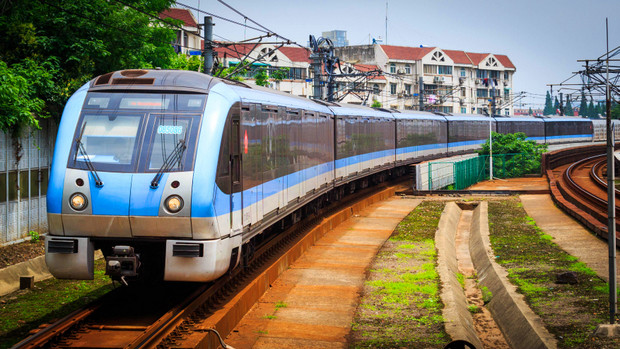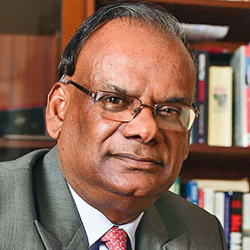Publicité
Are politics and prestige trumping sound finance and credible economics ? (Part I)
Par
Partager cet article
Are politics and prestige trumping sound finance and credible economics ? (Part I)


Behind the nice speeches regarding Metro Express the day of its laying of foundation stone, hides the subject of monetisation. Dr Rama Sithanen will analyse this project, in two other parts, in the days to come, and also all its implications.
The multimedia high tech display and the official compelling case for the metro express
The ground breaking ceremony of the Metro Express (ME) was a magnificently delectable spectacle, well-calibrated, choreographed and executed. Thoroughly deserved for the most prestigious and ambitious infrastructure project even undertaken in our country. All jazz and pizzazz in technology, style, form and tone with a virtual tour of the ME as the peak of the pageantry performance. Embroidered with panegyric rhapsodies such as: “A historic event, a new chapter in our history, a great colossal venture, a game changer, a paradigm shift, a critical success factor, a major stride towards a new era of development and to capture it all… a superior solution.”
The threads of the arguments, as articulated by the Prime Minister and Minister Bodha, look impeccable. They appear flawless. They range from ending the congestion nightmare to embracing a modern, safe, cleaner and efficient transport mode which is more cost effective, comfortable and reliable. The ME will drastically lower travel time, bring down commuting costs, cut back on car ownership and ridership, eliminate the inconvenience of traffic congestion, save on energy bill, reduce pollution, and curtail road accidents, all resulting into considerable improvement in economic efficiency. How could we continue to accept a road congestion that costs the nation Rs 4 billion per annum today and rising to Rs 10 billion in 2030?
The new transport mode will tremendously boost the construction sector, generate 7 000 full-time jobs and contribute Rs 13 billion to national output during the implementation phase. It has wider economic and social implications, with huge spillover effects due to urban regeneration and new poles of bustling activities in metro stations. It will eventually operate countrywide with extension to the West, South and North of the country and will even serve the airport with multiplier effects on tourism. Assurances are given that the concerns of all stakeholders, especially those likely to be impacted negatively, will be taken on board. Thus, the interests of workers of the transport industry, bus companies, individual bus and taxi owners will, ‘at all times’, be safeguarded after full consultation with them to ensure a win-win outcome. The budget will be affordable to the government and the fares reasonably priced for commuters. The free transport scheme, costing Rs 2 billion annually, will be reviewed to make it more sophisticated, more accountable and more attractive.
This is indeed very great stuff, even if it is not freshly baked, as the same consultants have been singing the same song from the same sheet for quite a long time. In the light of so much benefits, one is flabbergasted that independent commercial banks operating in Mauritius are extremely reluctant to fund a Rs 7 billion loan being sought by the government for the ME without a sovereign guarantee. It speaks volume of what they think of the project on its own merit.
The devil is always in the details and the monetisation of benefits and costs
Undoubtedly, all of us want an end to the current nightmare of traffic congestion, especially at the entrance and the exit of Port-Louis. Equally, we would like to have a modern, efficient, eco-friendly and cost-effective transportation system that meets the country’s future requirements and fosters new growth drivers. The Prime Minister is absolutely right that business as usual is not an option.
The question however is whether the ME is the superior solution, based on an objective set of criteria. As Minister of Finance and Economic Development for close to 10 years – and having studied all official reports on alternative modes of public transport until 2010 – and as an economist familiar with large public infrastructure funding, I have never been convinced by the case for the ME. We should not hold against some prominent members of the present government the fact that they were dead against the project, as recently as December 2014, when the ME was qualified as an unmitigated financial disaster. To be fair, many policy makers have, over the years, altered their view on the best transport mode, and probably for sound reasons, as the facts, the figures, the economics and the circumstances have evolved.
In his speech, the Prime Minister rightly referred to two key factors that have informed the choice of the ME.
They are:
i.A study of existing and future transport demand to underpin the decision;
ii.A careful and comprehensive assessment of the economic and social costs and benefits of the ME. These two elements have always constituted the basis of my doubt on the ME. And I shall develop them to justify my concerns.
While we have been peppered and overwhelmed with many broad arguments, vague generalisations and motherhood statements such as the positive spillover effects of the ME, its wider social and economic benefits, we have not seen any financial and economic analysis or monetisation of such gains. Nor any compelling study on how the current employees and bus operators of the transport industry will be ‘perfectly’ integrated into the new system. Or how the free transport subsidy of Rs 2 billion will be reengineered, rebalanced or redistributed?
One also suspects an unfortunate cynicism when reference is made to extending the ME to rural areas. One argument used against the ME is that rural taxpayers will contribute for a transportation system destined for urban dwellers only! This charge is obviated with the promise of stretching the ME to the West, North and South. How credible is such an undertaking with such low traffic density, knowing fully well that those who make that pledge will probably not be here to implement it?
Also, the seductive appeal of policy makers for large scale public projects that are charged with prestige, glory, and national pride is oblivious to the fact that such infrastructure often experiences long delays, incurs massive cost overruns, has huge opportunity costs and ends up as a money sink that imperils the finances and the economics of the country. There are many illustrations in developing countries.
While in office, I had four grounds to anchor my doubts and they have not materially changed.
i.Based on what has been presented on Friday last and in the absence of an accompanying document spelling out the key features of the ME, there is no evidence of its alleged superiority in terms of some vital components that constitute the quality of services to be provided (such as the comfort of commuters based on the ratio of standing to seating accommodation, the duration of the trip). This has major implications on both the financial forecasts and the monetisation of economic benefits;
ii.Critical mass of traffic, affordability and financing are at the heart of ME planning and development. Because it is very expensive and demand density is low, revenues rarely cover all costs. The financial risks, as opposed to the economic ones, are therefore extremely high and the ME could end up as a disaster that adds significantly to the annual budget deficit and to public debt, especially if the forecasts of traffic demand are not realistic;

iii. While there are clear socio-economic and environmental benefits, strong doubts subsist whether they will be sufficient to warrant such a phenomenal investment that could be a huge burden for future generation. Unless there is the temptation by consultants to make overly optimistic assumptions about economic benefits (the spill over effects) and to underestimate the economic costs (the impact on employees and operators of the current transport industry), resulting into a self-serving bias to make their case. Research in many countries demonstrates that the average cost escalation of Light Rail Transport is estimated at 45 % while demand projections show inaccuracies of around 85 % ; and
iv. The opportunity costs of the ME are simply too high and there are modern, proven, efficient and much more affordable alternative package of policies and measures to alleviate traffic congestion. They do exist in many developing countries.
I shall focus on these four issues only. I shall posit as to its technical feasibility, the alignment and technology, the procurement strategies and the choice of the concessionaire that will design, build, finance, operate and maintain the ME. I shall also postulate that the mode of transport shall be safe, secure, free of technical and maintenance hitches and eco-friendly. I shall further assume that the political, construction and legal risks can be managed and mitigated.
We are thus left with the quality of service, the forecasts of passenger demand, the estimation of financial costs and revenues and the monetisation of economic costs and benefits. And whether government and public subsidies will be necessary to implement and operate the ME.
I shall consider each of these critical points in the next two articles.
Are politics and prestige trumping sound finance and credible economics? (Part II)
Are politics and prestige trumping sound finance and credible economics? (PART III)
Publicité
Publicité
Les plus récents






